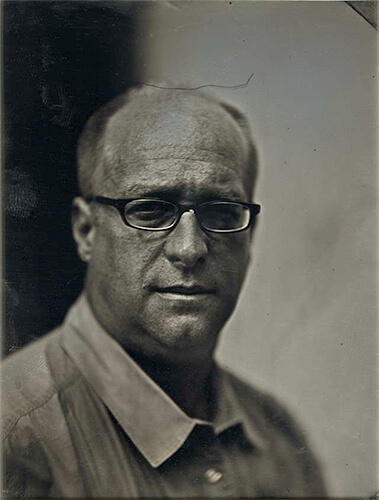Todd Hido (American, b.1968) is a prolific photographer whose works of suburban and urban homes have been shown in galleries and businesses throughout the nation. He was born in Kent, OH, and is now based in San Francisco, CA. He received a BFA in 1991 from Tufts University in Massachusetts, and an MFA from the California College of Arts and Crafts. He is currently an adjunct professor at the California College of Art in San Francisco.
TODD HIDO (b. 1968 in Kent, OH) is a San Francisco Bay Area-based artist who received his M.F.A. from the California College of Arts and Crafts and his B.F.A. from the School of the Museum of Fine Arts, Boston, and Tufts University. His photographs have been exhibited internationally, including solo exhibitions at the Cleveland Museum of Art, and the Kemper Museum of Contemporary Art in Kansas City, and are included in numerous museum collections, including the Whitney Museum of Art, Guggenheim Museum, San Francisco Museum of Modern Art, and the Los Angeles County Museum of Art as well as in many other public and private collections. His work has been featured in Artforum, The New York Times Magazine, Eyemazing, Metropolis, The Face, I-D, and Vanity Fair. In 2001 an award-winning monograph of his work titled House Hunting was published by Nazraeli Press and a companion monograph, Outskirts, was published in 2002. His third book, Roaming, was published in 2004. Between the Two, focusing on portraits and nudes, was published in 2007. His latest book of landscapes, A Road Divided, was published in 2010. In May of 2013 Excerpts from Silver Meadows was published by Nazraeli Press. He is an adjunct professor at the California College of Art, San Francisco, California.
Source: Rose Gallery
Drawing from childhood memories as a creative wellspring, Hido wanders endlessly, taking lengthy road trips in search of imagery that connects with his own recollections. For his landscapes the artist chooses to photograph during overcast days and often frames his images through the vantage point of his car, using the windshield as an additional lens. Through this unique process and signature color palette, he alludes to the quiet and mysterious side of suburban America, where uniform communities provide for a stable façade, while concealing the instability that lies within its walls. While Hido is notorious for photographing suburbia from the outside as his pictures of well-worn dwellings evidence, he has also entered the interiors of these houses and integrated the human form into his work. His ability to capture the inherent tensions of both the human body and landscapes marks his work as a starting point of a broader discussion. Any narrative inferred form his work is entirely a construct of the viewer’s imagination heightened by Hido’s power of sequencing photographs and his fascination with a cinematic style of image making.
Hido was born in 1968 in Kent, Ohio. He received his B.F.A. from the School of the Museum of Fine Arts, Boston, and Tufts University. In 1996 he earned his M.F.A. from the California College of Arts and Crafts where he was mentored by Larry Sultan. He is now an adjunct professor at the California College of Art, San Francisco. Hido has been the recipient of the Eureka Fellowship, Fleishhacker Foundation, Wallace Alexander Gerbode Foundation Visual Arts Award, and the Barclay Simpson Award. His latest show with Bruce Silverstein Gallery, Bright Black World is the artist's fourth solo exhibition with the gallery.
His photographs have been the subject of solo exhibitions at the Cleveland Museum of Art, and the Kemper Museum of Contemporary Art in Kansas City. Other major institutions that have previously exhibited Hido’s work include the Carnegie Museum of Art, Pittsburgh, Pennsylvania; Corcoran Gallery of Art, Washignton D.C.; Museum of Contemporary Photography, Chicago; Miami Art Museum, Florida; Netherland Architecture Institute, Rotterdam; Palazzo Ducale, Genova, Italy; Samsung Museum of Modern Art in Korea; and the San Francisco Museum of Modern Art.
Work by Hido is held in public and private collections including the Guggenheim Museum, New York; Los Angeles County Museum of Art; San Francisco Museum of Art; and the Whitney Museum of Art.
In 2001 an award-winning monograph of his work titled House Hunting was published by Nazraeli Press, followed by a companion monograph, Outskirts, published in 2002. His third book, Roaming, was published in 2004. Between the Two, focusing on portraits and nudes, and A Road Divided were respectively published in 2007 and 2010. A full volume of Silver Meadows, mined from Hido’s own experience growing up in Kent, was launched at Paris Photo 2012. Intimate Distance, published in 2016, is the first comprehensive monograph charting the career of the artist. Hido’s most recent publication, Bright Black World, will be released in late autumn 2018. This newest publication highlights the artist’s first significant foray extensively photographing territory outside of the United States, chronicling a decidedly new psychological geography. The artist lives and works in the San Francisco Bay Area.
Source: Bruce Silverstein
